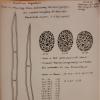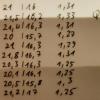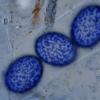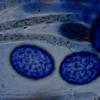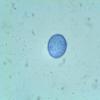
14-11-2025 18:31
 Lothar Krieglsteiner
Lothar Krieglsteiner
Hello,can somebody provide me with a file of:Rothe

14-11-2025 16:26
 Marian Jagers
Marian Jagers
Hello everyone, On dead wood of Cytisus scoparius

12-11-2025 09:25
 Viktorie Halasu
Viktorie Halasu
Hello, I need help with a pale terrestric Pseudom

11-11-2025 20:16
Bohan JiaHi, lastly I have found these tiny yellow decayin

09-11-2025 13:20
Hello.A tiny ascomycete, appearing as erupting gra

08-11-2025 00:29
 Francois Guay
Francois Guay
I found this species in Quebec, Canada, on herbace
Scutellinia cf. kerguelensis
Andreas Gminder,
15-08-2021 01:39
 Bonsoir chers collègues,
Bonsoir chers collègues,today my girlfreind and I have found a bright orange-red, short-haired Scutellinia on wet muddy ground.
The strange ornamentation pattern and the broadly ellipsoid spores, together with short (< 300 µm) and non-rooting (or with one root) hairs led us to S. superba, but the perispore is not loosening with lactic acid.
Lastly we concluded that it is another collection of S. kerguelensis, which we didn't key out before, because the spores were quite small.
In the key of Benat S. kerguelensis is noted as a complex - is there already some effort to separate the species in this complex? Are there small-spored and long-spored kerguelensis? We have three collections with spores 22-27 x 15-17 µm (Q = 1,5-1,6), 21-23 x 15,5-17 µm (Q = 1,33-1,44) and this collection with 20-21,8 x 15,7-17 µm (Q = 1,25-1,33) - always measured oin water. The first bigger-spored collection had hairs with 1-3 roots, the smaller-spored have hairs with 0-1 roots.
Any new insights in this complex?
thank you and all the best,
Andreas and Sylvie
Andreas Gminder,
20-08-2021 01:25

Re : Scutellinia cf. kerguelensis
Bonsoir,
les Scutelliniologues, ils sont en vacances? ;-)
amicalement,
Andreas
les Scutelliniologues, ils sont en vacances? ;-)
amicalement,
Andreas
Malcolm Greaves,
21-08-2021 12:13
Re : Scutellinia cf. kerguelensis
Hi Andreas, it looks as though even those who are interested in this group like myself haven’t the technical skill or sufficient specimens to take it further in defining the various species within the “complex” groups.
Mal
Ps I have also found more than one specimen that fitted perfectly with S superba but did not manage to get the perispore loosening reaction expected
Mal
Ps I have also found more than one specimen that fitted perfectly with S superba but did not manage to get the perispore loosening reaction expected
Andreas Gminder,
21-08-2021 21:56

Re : Scutellinia cf. kerguelensis
Dear Mal,
thank you very much for your answer. As I'm not too deep into the ascos, I'm in most genera not on the todays knowledge level. Therefore its good to know that this complexes have not been resolved yet, or at least there is no publication about it. Also your hints towards S. superba is very useful. We will try to collect more of these complex, as it seems that these Scutellinias are not too rare in my area. I have never seen a kerguelensis for 30 years, and now we have three or four collections in 18 month and have not even searched for Scutellinias ....
all the best,
Andreas
thank you very much for your answer. As I'm not too deep into the ascos, I'm in most genera not on the todays knowledge level. Therefore its good to know that this complexes have not been resolved yet, or at least there is no publication about it. Also your hints towards S. superba is very useful. We will try to collect more of these complex, as it seems that these Scutellinias are not too rare in my area. I have never seen a kerguelensis for 30 years, and now we have three or four collections in 18 month and have not even searched for Scutellinias ....
all the best,
Andreas
DirkW,
22-08-2021 12:12

Re : Scutellinia cf. kerguelensis
hi andreas,
my suspicion is, that the feature of schumacher with "loosening spore wall" is a bit overstressed and not a good key-feature. I had much collections of s. torrentis and never saw this clearly. Instead a variable deformation of shape which is common by using cotton blue in many scutellinias! to me your collection would be a s. superba, my personal understanding of a "classical" kerguelensis ia a species with longer hairs and a very fine, inconspicous ornamentation of isolated warts. but I'm not aware of recent molecular-based complex-studies (if they exist at all ...).
beste grüße
dirk
Malcolm Greaves,
23-08-2021 14:57
Viktorie Halasu,
23-08-2021 16:22

Re : Scutellinia cf. kerguelensis
Hello Dirk and Mal,
when the perispore didn't peel off, did you try to add a drop of pure lactic acid and heat it again? Maybe, sometimes the concentration of LACB that is sufficient for not overstaining doesn't hold enough LA to loosen the perispore?
Viktorie
when the perispore didn't peel off, did you try to add a drop of pure lactic acid and heat it again? Maybe, sometimes the concentration of LACB that is sufficient for not overstaining doesn't hold enough LA to loosen the perispore?
Viktorie
Malcolm Greaves,
23-08-2021 19:03
Re : Scutellinia cf. kerguelensis
No didn’t try that, no lactic acid.
Andreas Gminder,
23-08-2021 21:54

Re : Scutellinia cf. kerguelensis
Hello,
but I did in my collection, as I suspected it to peal of, and I used pure lactic acid (80%) too. But as my cotton blue is 0,3 gr cotton blue in 100 ml lactic acid 80%, I didn't expect differences anyway.
all the best,
Andreas
but I did in my collection, as I suspected it to peal of, and I used pure lactic acid (80%) too. But as my cotton blue is 0,3 gr cotton blue in 100 ml lactic acid 80%, I didn't expect differences anyway.
all the best,
Andreas
Nicolas VAN VOOREN,
26-08-2021 19:01

Re : Scutellinia cf. kerguelensis
Heelo Andreas.
Your collection surely belongs to the S. kerguelensis complex. The revision of this complex requires that a recent collection of this species made in the Kerguelen Island will be available for morphological and molecular study. As you know this is not easy to get material from this island!
without this first step it will be hard to separate the other collections.
Your collection surely belongs to the S. kerguelensis complex. The revision of this complex requires that a recent collection of this species made in the Kerguelen Island will be available for morphological and molecular study. As you know this is not easy to get material from this island!
without this first step it will be hard to separate the other collections.
Edouard Evangelisti,
30-08-2021 20:30

Re : Scutellinia cf. kerguelensis
Hello,
I will do ITS sequencing for several Scutellinia collections in a month or so (including several specimens collected in a French national Park). If you are interested I am happy to include yours. I will try and get material from other sources too. I am not saying this will resolve any species complex, but it may be a good start for comparison.
Best wishes,
Edouard
Edouard

